Fused Cast Zirconia Corundum Blocks(AZS) are refractory materials produced by melting industrial alumina powder and selected zircon sand at temperatures exceeding 2300°C through electric arc melting, followed by casting. Their core composition is the Al₂O₃-ZrO₂-SiO₂ ternary system, with ZrO₂ content ranging from 33% to 45%. The primary mineral constituents are a eutectoid mixture of corundum (α-Al₂O₃) and baddeleyite (ZrO₂), supplemented by a small amount of glassy phase filling the intercrystalline voids.
Leveraging their unique microstructure and exceptional performance, fused cast zirconia corundum blocks have become indispensable key materials in the modern glass industry. A thorough understanding of their characteristics and proper usage is crucial for ensuring the long-term stable operation of glass furnaces, enhancing glass product quality, and reducing production costs. As the glass industry progresses towards higher quality and efficiency, the performance requirements for AZS blocks will continue to rise, driving ongoing advancements in related research and application technologies.
I. Shrinkage Characteristics of Fused Cast Zirconia Corundum Blocks
II. Microstructure of Fused Cast Zirconia Corundum Blocks
III. Phase Transformation Characteristics of Zirconia
IV. Erosion Mechanism of Fused Cast Zirconia Corundum Blocks
V. Alteration Mechanism of Fused Cast Zirconia Corundum Blocks
VI. Residual Block Analysis of Fused Cast Zirconia Corundum Blocks
VII. Conclusion and Outlook
Defects such as shrinkage cavities, porosity, internal stresses, cracks, and deformation in castings are all related to the shrinkage of the molten material. Higher pouring temperatures result in greater liquid shrinkage.
Solidification shrinkage manifests as a continued decline in the liquid level within the mold cavity. Thus, the combination of solidification and liquid shrinkage is the fundamental cause of contradictions leading to shrinkage cavities in castings, with AZS volumes shrinking by 12% to 15%.
Solid-state shrinkage is solely expressed as a reduction in external dimensions, with AZS exhibiting a linear shrinkage rate of 1%. Molten material solidification tests indicate that the solidification rate is rapid, with an 8-millimeter solidified layer forming within 36 seconds of contact between the molten material and the mold. This hardened layer, known as a protective layer, restricts the pressure of the flowing molten material, allowing a 25-millimeter-thick surface to solidify within just 6 minutes. This process results in the formation of a zirconium-rich layer on the casting surface and a dense, zirconium-rich zone at the bottom due to the sinking of the molten material, while less fusible oxides, including the glassy phase, accumulate in the upper shrinkage cavity area of the casting.
Practical experience has demonstrated that when designing glass furnaces and utilizing zirconia corundum blocks, precision grinding should not be applied to surfaces in contact with the glass melt in the glass furnace to avoid wearing away the zirconium-rich layer, which would reduce the block‘s erosion resistance and service life. Instead, only rough processing to remove surface sand and impurities is necessary, ensuring it does not affect the quality of the glass melt. However, contact surfaces must be finely ground and assembled. For areas directly exposed to the flowing and scouring action of high-temperature glass melts above 1500°C, such as the throat, cover plates, glass furnace sills, and doghouse corners, 41# oxidation method shrinkage-free zirconia corundum blocks (AZS 41 #WS)should be specially selected, along with other high-quality sintered refractory materials. The glass furnace should be constructed and accepted in strict accordance with national glass furnace construction standards by qualified design and construction units, and operated in compliance with norms to maximize the service life of the entire glass furnace.
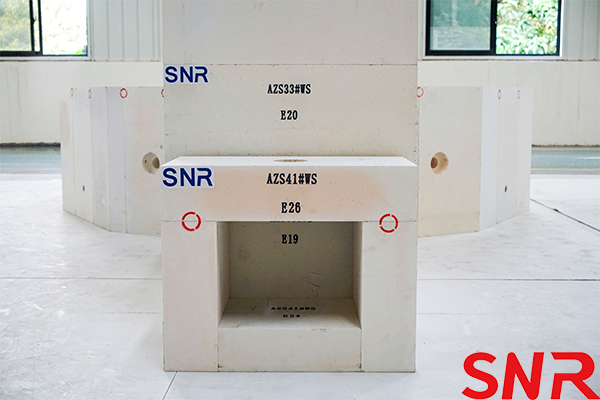

Compared to sintered refractories, fused cast refractories primarily offer the advantage of intercrystalline bonding, with tightly arranged crystals and few pores. The main crystal phases are interbonded, and although low-melting phases may exist in many fused cast AZS blocks, they fill the gaps in the crystal skeleton and do not play a dominant role. Key characteristics include:
Presence of shrinkage cavities but a dense crystal structure with very low porosity.
High purity and elevated load softening temperatures.
High mechanical strength at both room and elevated temperatures.
Exceptional chemical stability and resistance to glass erosion.
High thermal conductivity and a tendency for high-temperature liquid phase precipitation.
Poor thermal stability, with intolerance to rapid heating and cooling.
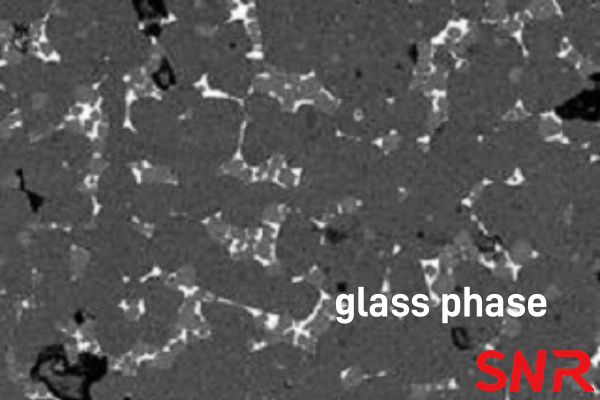
Monoclinic ZrO2⇌Tetragonal ZrO2⇌Cubic ZrO2⇌Liquid
Heating schedule for glass furnace firing: Understanding the crystal phase characteristics of zirconia indicates that during glass furnace firing for glass melting furnaces, when the temperature ranges from 950°C to 1150°C, the temperature should only be increased by 3.3°C per hour. Rapid increases or drops must be avoided; otherwise, irreversible phase transformations between monoclinic and tetragonal baddeleyite crystals can cause volume effects in the blocks, leading to abnormal shrinkage or expansion. This can result in spalling, detachment, and irregular transverse and longitudinal cracks, directly affecting the glass furnace‘s service life. To achieve optimal performance with zirconia corundum blocks, conditions permitting, the temperature can be raised above 1150°C at a rate of 9.5°C per hour during the main firing phase, which should last no less than 16 hours. In summary, the temperature should not exceed 1520°C in less than 310 hours.
Temperature conditions
Chemical erosion conditions
Physical erosion conditions
Time conditions
These four conditions do not exist independently during the erosion of fused cast zirconia corundum blocks but rather coexist and interact.
Fused cast zirconia corundum blocks must adapt to temperature increases or holding processes for reasonable durations. Excessive high-temperature use or accidental rapid cooling, as well as failing to control reasonable durations, can cause spalling damage or severe erosion to the blocks, reducing the glass furnace‘s service life.
Chemical erosion caused by reactions between the molten glass and the fused cast zirconia corundum blocks primarily involves the erosion from volatile components in soda-lime-silica glass compositions. Physical mechanical scouring erosion occurs at the upper edges of pool wall blocks, doghouse corners, throat cover plates, and glass furnace sills. Cracks and pores in the fused cast zirconia corundum blocks, particularly at the horizontal lines of the solid-liquid-gas three-phase interface, are especially susceptible to erosion. Overall, chemical and physical factors work together to exponentially accelerate the erosion of fused cast zirconia corundum blocks, leading to various defects in the glass such as stones, streaks, discoloration, and bubbles.
Chemical erosion caused by reactions between fuel ash and combustion products with the fused cast zirconia corundum blocks is particularly intense, especially when heavy oil and coal gas containing sulfur components release sodium sulfite, which strongly reacts with and pollutes the blocks.
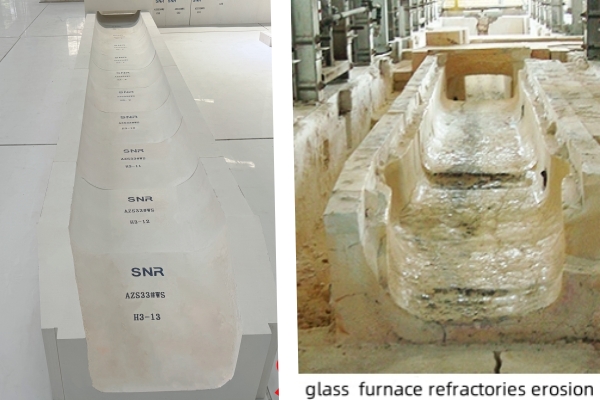

V. Alteration Mechanism of Fused Cast Zirconia Corundum Blocks
Zirconia corundum blocks are primarily composed of chemically stable corundum and baddeleyite eutectoids tightly bonded together. When eroded by alkaline oxides in the molten glass, the pool wall blocks dissolve at the interface with the glass melt, simultaneously precipitating a zirconia corundum crystal and alkaline chemical component eutectic mucus from the glass mixture. This mucus adheres to the surface of the block in contact with the glass melt, forming a brownish-yellow interface protective glaze film that prevents and weakens the penetration of glass raw materials into the block‘s internal capillary pores, thereby reducing erosion.
If the glass melt level drops or flows continuously, scouring away the protective glaze film, a new eutectic liquid will re-precipitate on the block‘s surface, forming a new glaze film. This process repeats, with the block being eroded and scoured by the glass melt, creating varying degrees of longitudinal and transverse grooves. This fully illustrates that after the glassy phase is replaced by the glass melt and reacts with the corundum in the crystalline structure to form a stable zircon layer, which also serves as a high-viscosity glaze protective layer.
If the outer upper edge of the pool wall block is cooled and maintained using forced air cooling according to standards, stabilizing the temperature variations in the glass furnace and preventing abrupt temperature increases or decreases, the zirconia corundum block will exhibit greater resistance to erosion by the glass melt.
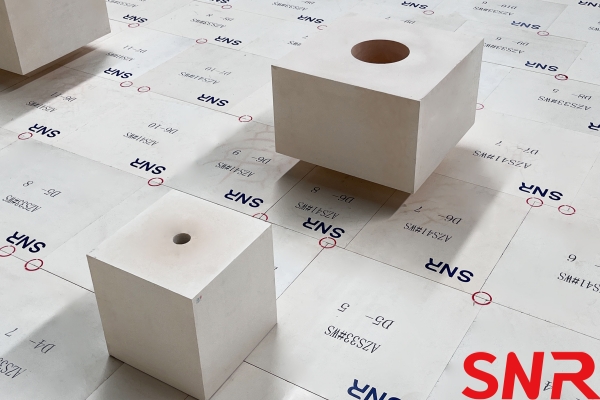

VI. Residual Block Analysis of Fused Cast Zirconia Corundum Blocks
The zirconia corundum blocks in the flame space of the glass furnace contain 20% glassy phase, which will soften and seep out at 1400°C, flowing away with increasing temperature along with carbides and iron-titanium impurities present in the block. An oxidizing atmosphere forms in the glass furnace, extruding the molten glassy phase and causing the crystalline phases to drip due to the loss of the glassy phase binder.
When a cross-section of the residual portion of a zirconia corundum pool wall block after erosion in a glass furnace is examined, it can be divided into three zones based on color and mineral composition: the original block zone (original block color), the altered zone (new minerals formed on the eroded surface), and the transition zone (remaining portion).
Physical and chemical composition analyses of the used block reveal that the corundum-baddeleyite eutectoid decreases from 50% in the original block to 40%, while the porosity increases from 2% to 15%. The zirconium content decreases from 34% to 31%, and the sodium content increases from 1.38% to 5.85%. This indicates significant changes in the physicochemical indicators of the zirconia corundum block after use in a glass melting furnace, severely reducing its resistance to glass erosion. This fully demonstrates that residual spent zirconia corundum blocks are not recommended for reuse in the main sections of glass furnaces after their service life has ended, as doing so could lead to adverse consequences. Therefore, physicochemical indicator tests must be conducted on zirconia corundum blocks used in glass melting furnaces. The results will undoubtedly deviate from and not meet the various indicator specifications set by national building materials standards. Such results also cannot replace the sampling methods and physicochemical indicators used to determine the original block‘s production quality disputes and should not serve as legally valid evidence for judging original block production quality issues.
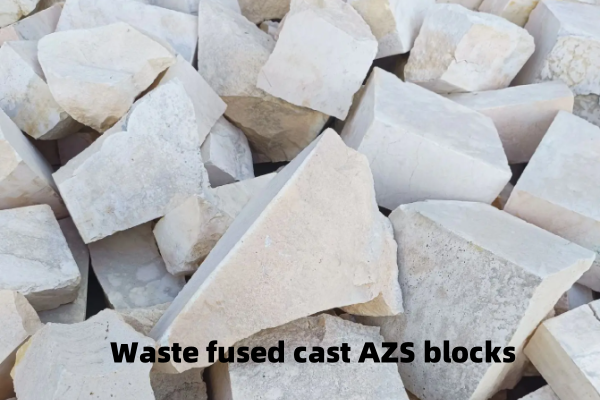

Leveraging their unique crystal structure and exceptional resistance to erosion, fused cast zirconia corundum blocks have become indispensable key materials for modern glass furnaces. However, their complex shrinkage characteristics, zirconia phase transformation behaviors, and special erosion mechanisms require users to have a deep understanding of the material‘s essence and strictly control every aspect from material selection, construction to operation.
Future development directions should include:
Developing new AZS materials with lower shrinkage cavity rates.
Optimizing glass furnace firing curves and temperature control techniques.
Researching more effective surface protection methods.
Establishing a comprehensive post-use evaluation system.
Only through scientific material selection, standardized construction, and meticulous operation can the performance advantages of fused cast zirconia corundum blocks be fully realized, maximizing the service life of glass furnaces and providing reliable support for the sustainable development of the glass industry.
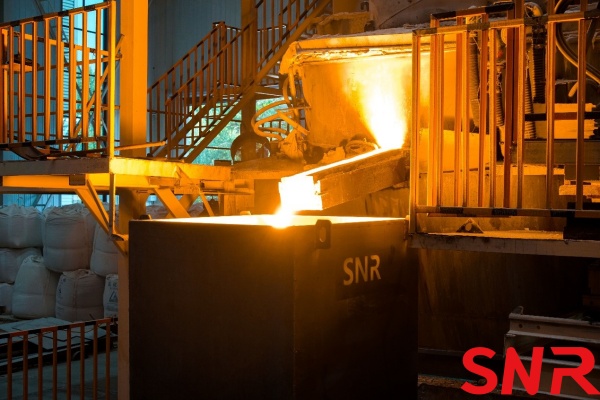

 If you have any needs, you can contact me at any time.
If you have any needs, you can contact me at any time.
Web: www.snr-azs.com
Email:wendy@snrefractory.com


